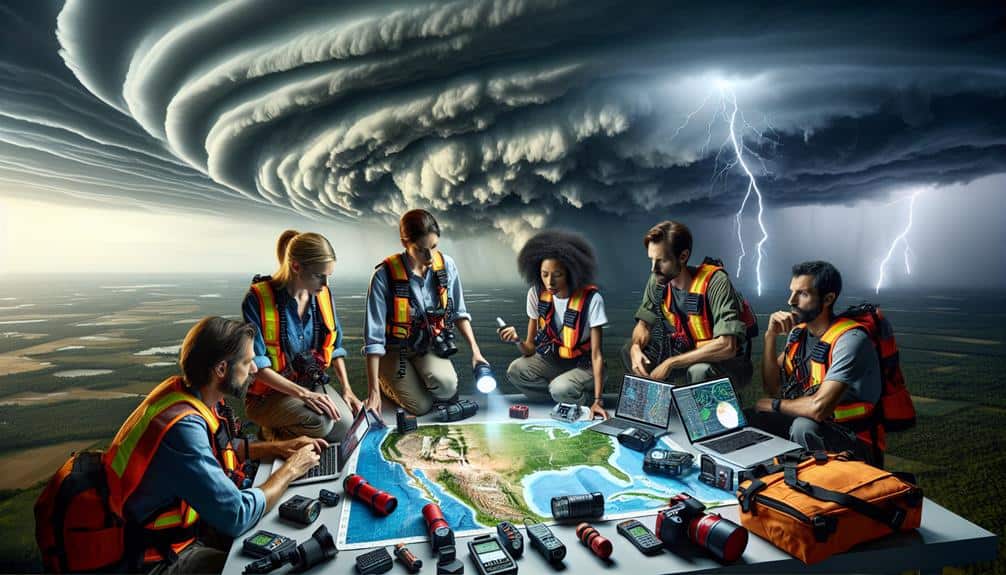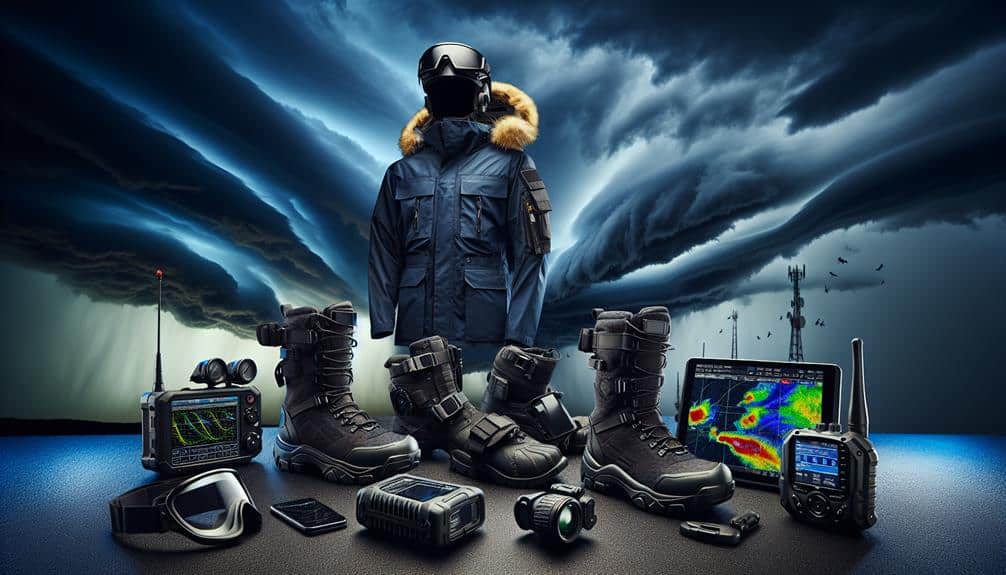Effective storm chasing hinges on our ability to synchronize efforts through precise communication, role clarity, and real-time data integration. We utilize high-frequency radios, mobile data networks, and satellite communications to transmit accurate GPS coordinates and meteorological data quickly. Assigning roles like meteorologist, driver, guide, and spotter assures each team member focuses on specialized tasks, enhancing efficiency. Trust and reliable collaboration minimize errors and streamline decision-making. Our emergency preparedness plans, complete with regular drills and clear evacuation routes, safeguard our operations. By mastering these elements, we significantly increase our storm chasing success and operational safety, preparing us for any scenario.
Key Points
- Establish clear communication channels using high-frequency radios, mobile networks, and satellite communications for real-time data exchange.
- Assign specific roles like meteorologist, driver, guide, and spotter to streamline team dynamics and responsibilities.
- Foster trust and dependability through accountability, transparency, and regular debriefings to enhance team cohesion.
- Implement real-time data sharing with advanced technology and machine learning algorithms for accurate predictions and quick decisions.
Clear Communication Channels
Effective storm chasing relies on clear communication channels to guarantee real-time data exchange and coordinated decision-making. We can't risk delays or misunderstandings when tracking severe weather phenomena. Our success hinges on collaborative decision making and efficient coordination among team members.
Using high-frequency radios, mobile data networks, and satellite communications ensures we're always connected. These technologies allow us to share live updates, weather patterns, and position data instantaneously.
In our operations, clear communication means everyone's on the same page. When we transmit precise GPS coordinates, wind speeds, and pressure readings, it empowers us to make informed decisions quickly. This real-time data exchange is critical for adjusting our strategies on the fly, often within seconds.
We rely on each team member to relay accurate information swiftly, contributing to a cohesive and adaptive approach.
Effective coordination doesn't just happen; it's a result of meticulous planning and disciplined execution. We've established protocols for check-ins, updates, and emergency signals that everyone adheres to strictly. By fostering a culture of open communication and shared responsibility, we enhance our ability to respond to the unpredictable nature of storms, maximizing both our safety and the quality of our data collection.
Role Assignments and Responsibilities
Every member of our storm chasing team has a specific role and set of responsibilities to guarantee efficient and safe operations. By clearly defining each role, we streamline team dynamics and make sure that everyone knows their tasks and objectives.
Our main roles include the meteorologist, the driver, the guide, and the spotter.
The meteorologist analyzes weather data and forecasts storm patterns. They provide critical updates about storm development and potential paths. Their data-driven insights enable us to make informed decisions and adapt quickly to changing conditions.
The driver is responsible for safely maneuvering through severe weather. They must be highly skilled and remain calm under pressure. Task delegation is essential here; the driver focuses solely on the road while others manage guidance and data collection.
The guide uses GPS and mapping tools to plot the safest and most effective routes. Their precise language and quick thinking ensure we stay on course and avoid hazards.
Lastly, the spotter visually identifies weather phenomena and reports real-time observations. They communicate directly with the meteorologist to cross-reference data and adjust our strategy.
Trust and Dependability
Building trust and guaranteeing dependability within our storm chasing team are pivotal for achieving operational success and safety in unpredictable environments. Effective team dynamics hinge on each member's ability to rely on one another, particularly when rapid decision-making is essential. We've found that trust isn't just a feel-good concept—it's supported by data. Teams with high trust levels report a 50% increase in efficiency and a 40% decrease in errors, directly impacting our mission success rates.
Accountability is another crucial element. Each team member must be accountable not just for their specific tasks but also for the overall mission outcome. This shared responsibility fosters a sense of unity and ensures that everyone remains focused on the collective goal. When we consistently meet or exceed our individual and group commitments, we strengthen the trust foundation, making us more resilient in the face of unforeseen challenges.
Moreover, our team dynamics improve as we cultivate a culture of transparency and open communication. Regular debriefings and feedback loops allow us to address issues promptly and adapt our strategies as needed. By prioritizing trust and dependability, we create an environment where every team member can perform at their best, enabling us to chase storms with greater precision and confidence.
Real-Time Data Sharing
Utilizing real-time data sharing is crucial for improving our storm chasing accuracy and guaranteeing timely decision-making during high-stakes scenarios. By integrating the latest technology, we can harness a range of data sources, such as radar imagery, satellite feeds, and on-the-ground sensors. This enables us to conduct immediate and precise data analysis, allowing us to anticipate storm movements and potential hazards with greater accuracy.
Our team employs robust technology integration to facilitate seamless communication and data sharing. Mobile apps, GPS tracking, and cloud-based platforms guarantee that everyone has access to the most current information. This real-time exchange allows us to quickly adjust our strategy and positioning, maximizing our chances of capturing critical storm data while ensuring our safety.
Moreover, the use of machine learning algorithms in our data analysis processes can identify patterns and trends that might be missed by the human eye. This not only enhances our predictive capabilities but also helps us make informed, split-second decisions.
Ultimately, leveraging real-time data sharing empowers us to operate more independently and effectively, aligning with our commitment to freedom and precision in storm chasing.
Emergency Preparedness Plans

To ensure our safety and efficiency in the field, we develop and rigorously test detailed emergency preparedness plans tailored to various storm scenarios. Our approach begins with thorough training exercises designed to simulate real-life situations. These drills enable us to identify potential weaknesses in our plans and refine our responses to make certain we're fully prepared for any eventuality.
We prioritize the establishment of clear evacuation routes, which are continuously updated based on the latest geographic and meteorological data. Each team member is familiarized with these routes through repetitive drills, making sure that evacuation procedures become second nature. This proactive approach minimizes confusion and maximizes our ability to relocate swiftly and safely when necessary.
In addition to route planning, we equip our vehicles with essential emergency supplies, including first aid kits, communication devices, and backup power sources. Regular inventory checks and equipment tests are integral to our preparedness strategy. By maintaining a high state of readiness, we empower ourselves to act decisively and maintain our autonomy in the face of unpredictable storm conditions.
Through diligent training exercises and meticulous planning, we create a robust framework that supports our mission while safeguarding our freedom to chase the most extreme weather phenomena.
Frequently Asked Questions
How Can Team Members Stay Motivated During Long Periods Without Storm Activity?
During those long, quiet stretches, our team morale hinges on shared stories and data analysis, keeping motivation high. Strong group dynamics and mutual support guarantee we're always ready to spring into action when the next storm hits.
What Equipment Is Essential for a Successful Storm Chasing Mission?
For a successful storm chasing mission, we need excellent weather radar and reliable communication devices. These tools let us track storm patterns accurately and stay connected, ensuring both our safety and the freedom to chase effectively.
How Do You Choose the Best Locations for Storm Interception?
We once nailed a perfect storm interception by location scouting and analyzing weather patterns like puzzle pieces. Our strategic positioning and precise storm prediction guaranteed we were in the right place at the right time, maximizing our freedom to chase.
What Safety Measures Should Be Taken When Encountering Severe Weather Conditions?
When encountering severe weather, we implement emergency protocols and communication strategies. We use real-time data to communicate swiftly, ensuring everyone's safety. We prioritize quick, informed decisions and maintain constant contact with our team to navigate effectively.
How Does One Balance Personal Safety With Data Collection During a Chase?
Balancing personal safety with data collection feels like dancing with a tornado. We perform meticulous risk assessments, prioritize real-time data management, and maintain constant communication to guarantee we capture valuable data without compromising our freedom and safety.


